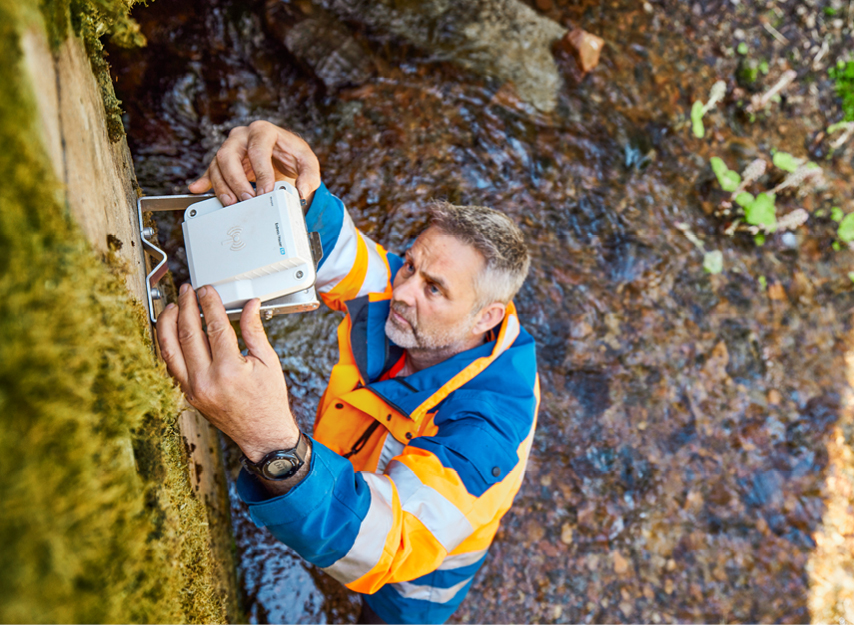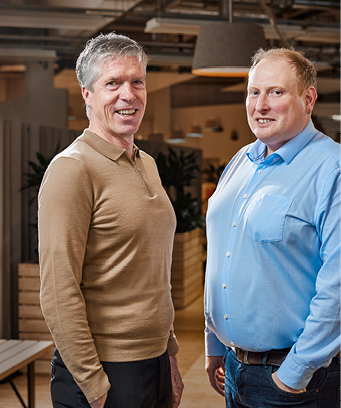Faster off the mark
In an increasingly complex world, Endress+Hauser is taking steps to open up to people and organizations outside the company in a collaborative search for innovations. The approach has already made it possible to quickly gain ground in the field of AI.

When a river unexpectedly overflows its banks somewhere in central Europe, Florian Falger often receives a phone call the very next day. The market manager helped develop Endress+Hauser’s Netilion flood monitoring early-warning system. With input from sensors and artificial intelligence, it is capable of predicting if, when and where a flood might happen. “That way, the responsible authorities can make the right decisions at the right time and take protective measures, for example to prevent damage,” says Falger, an industrial engineer by training. The system is unique for its type – and that is not the only thing setting it apart: there was just a year between the start of the project and market rollout.
By any measure, 12 months is not much time to develop a finished product. For a solution that combines sensors with AI based software, though, such pace is comparable to the speed of light. “That it went so fast is thanks to a new, agile department and our open innovation approach,” says Dr Simon Zühlke, a strategy expert at the Endress+Hauser product center for level and pressure measurement. Open innovation means the company is purposefully opening up to outside partners in the active search for innovation alliances. “We now live in a dynamic world where no one can do it all on their own,” says Zühlke, a process engineer. “Pooling skills and knowledge makes it faster to tap into new fields.”
Four years ago, Zühlke attended a start-up convention at Ruhr University in Bochum, Germany. There he encountered Okeanos, a start-up founded by two hydrologists who were looking to digitalize the world of water management using data driven approaches, including AI. “Even after just a few minutes, it was clearly a perfect match,” Zühlke says. At the time, Endress+Hauser had just launched the world’s first wireless 80 gigahertz radar sensor for monitoring levels in plastic tanks. The sensor uses its wireless technology to transmit data to the cloud. “On the one hand, we were seeking new applications for the battery- operated sensor, such as surface water monitoring in remote locations,” Zühlke explains. “On the other hand, we wanted to get more out of the sensor data.” Okeanos for its part was also immediately attracted to the measurement technology specialists. “Endress+Hauser is very good at recording data – and we’re very good at analyzing it,” says Okeanos co-founder Dr Benjamin Mewes.

1
A new wireless sensor was the inspiration behind the development of the flood warning system.

2
Endress+Hauser strategy expert
Dr Simon Zühlke and market manager Florian Falger are the minds behind the partnership with Okeanos.
Prediction, not just measurement
The partners initially experimented with digitalizing storm water overflow basins using measurements and an algorithm. But then, in 2021, catastrophic flooding hit Germany. “Suddenly, there was a major societal need,” Falger says. “We asked ourselves: ‘Could we use the radar sensor and AI to leverage water level measurement and turn it into a flood warning system for small bodies of water?’” A newly set up internal innovation lab got to work on the idea. “There we operate outside of the standard processes, using agile methods, to work on new products and solutions. We cooperate closely with customers – and we enjoy a lot of freedom,” Falger explains.
The result is an optimal blend of an idea, a business start-up and knowledge. Endress+Hauser provided level measuring devices, soil moisture sensors from its IMKO subsidiary and precipitation gauges to supply the required measurements and a cloud platform. Okeanos brought in hydrological knowledge (the founders had written their dissertations on flood forecasting) along with the AI algorithm. This merges measurements with other data in the cloud and delivers a clear forecast, saving users the task of interpreting the numbers. AI training was in cooperation with pilot customers. The system is already in widespread use. “That gives local communities up to 45 minutes of advance warning in the event of a potential flood,” Falger says. “And we want to make that window bigger still.”
Published 22.07.2024, last updated 21.08.2024.
Dive into the world of the process industry through new exciting stories every month with our «changes» newsletter!









